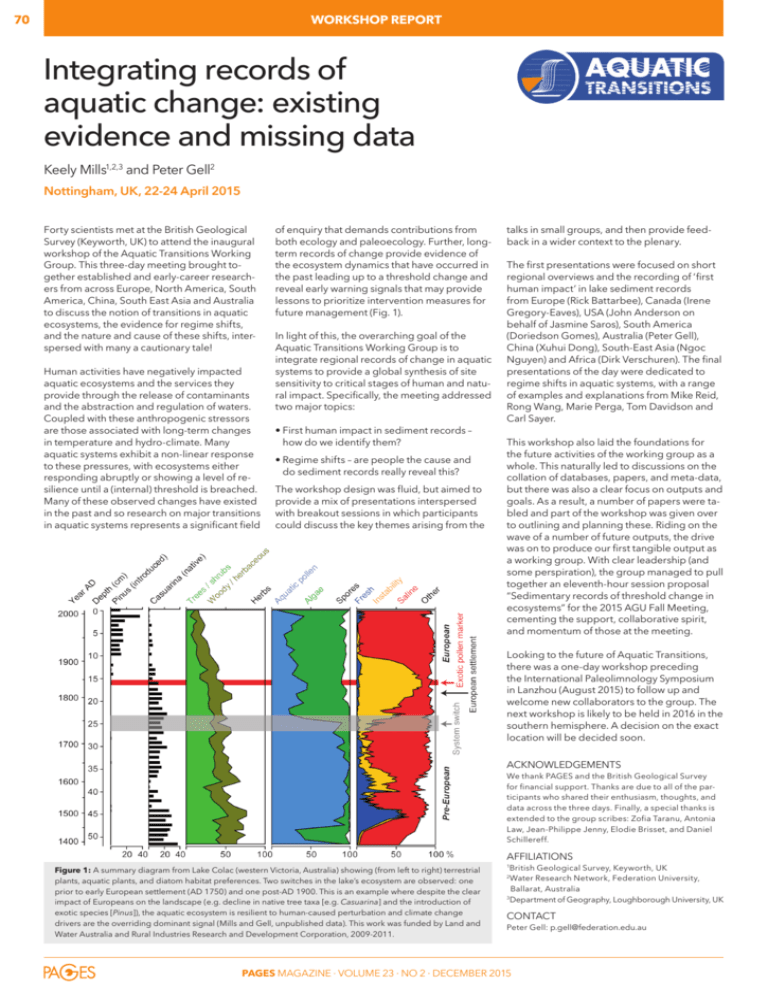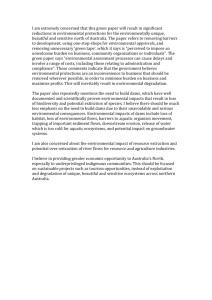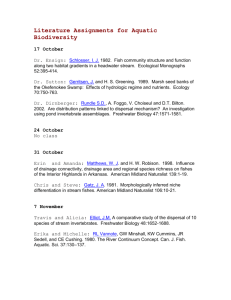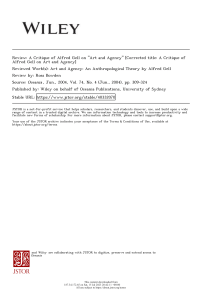Integrating records of aquatic change: existing evidence and
advertisement

WORKSHOP REPORT 70 Integrating records of aquatic change: existing evidence and missing data Keely Mills1,2,3 and Peter Gell2 Nottingham, UK, 22-24 April 2015 Forty scientists met at the British Geological Survey (Keyworth, UK) to attend the inaugural workshop of the Aquatic Transitions Working Group. This three-day meeting brought together established and early-career researchers from across Europe, North America, South America, China, South East Asia and Australia to discuss the notion of transitions in aquatic ecosystems, the evidence for regime shifts, and the nature and cause of these shifts, interspersed with many a cautionary tale! Human activities have negatively impacted aquatic ecosystems and the services they provide through the release of contaminants and the abstraction and regulation of waters. Coupled with these anthropogenic stressors are those associated with long-term changes in temperature and hydro-climate. Many aquatic systems exhibit a non-linear response to these pressures, with ecosystems either responding abruptly or showing a level of resilience until a (internal) threshold is breached. Many of these observed changes have existed in the past and so research on major transitions in aquatic systems represents a significant field of enquiry that demands contributions from both ecology and paleoecology. Further, longterm records of change provide evidence of the ecosystem dynamics that have occurred in the past leading up to a threshold change and reveal early warning signals that may provide lessons to prioritize intervention measures for future management (Fig. 1). In light of this, the overarching goal of the Aquatic Transitions Working Group is to integrate regional records of change in aquatic systems to provide a global synthesis of site sensitivity to critical stages of human and natural impact. Specifically, the meeting addressed two major topics: • First human impact in sediment records – how do we identify them? • Regime shifts – are people the cause and do sediment records really reveal this? The workshop design was fluid, but aimed to provide a mix of presentations interspersed with breakout sessions in which participants could discuss the key themes arising from the talks in small groups, and then provide feedback in a wider context to the plenary. The first presentations were focused on short regional overviews and the recording of ‘first human impact’ in lake sediment records from Europe (Rick Battarbee), Canada (Irene Gregory-Eaves), USA (John Anderson on behalf of Jasmine Saros), South America (Doriedson Gomes), Australia (Peter Gell), China (Xuhui Dong), South-East Asia (Ngoc Nguyen) and Africa (Dirk Verschuren). The final presentations of the day were dedicated to regime shifts in aquatic systems, with a range of examples and explanations from Mike Reid, Rong Wang, Marie Perga, Tom Davidson and Carl Sayer. This workshop also laid the foundations for the future activities of the working group as a whole. This naturally led to discussions on the collation of databases, papers, and meta-data, but there was also a clear focus on outputs and goals. As a result, a number of papers were tabled and part of the workshop was given over to outlining and planning these. Riding on the wave of a number of future outputs, the drive was on to produce our first tangible output as a working group. With clear leadership (and some perspiration), the group managed to pull together an eleventh-hour session proposal “Sedimentary records of threshold change in ecosystems” for the 2015 AGU Fall Meeting, cementing the support, collaborative spirit, and momentum of those at the meeting. Looking to the future of Aquatic Transitions, there was a one-day workshop preceding the International Paleolimnology Symposium in Lanzhou (August 2015) to follow up and welcome new collaborators to the group. The next workshop is likely to be held in 2016 in the southern hemisphere. A decision on the exact location will be decided soon. ACKNOWLEDGEMENTS We thank PAGES and the British Geological Survey for financial support. Thanks are due to all of the participants who shared their enthusiasm, thoughts, and data across the three days. Finally, a special thanks is extended to the group scribes: Zofia Taranu, Antonia Law, Jean-Philippe Jenny, Elodie Brisset, and Daniel Schillereff. Figure 1: A summary diagram from Lake Colac (western Victoria, Australia) showing (from left to right) terrestrial plants, aquatic plants, and diatom habitat preferences. Two switches in the lake’s ecosystem are observed: one prior to early European settlement (AD 1750) and one post-AD 1900. This is an example where despite the clear impact of Europeans on the landscape (e.g. decline in native tree taxa [e.g. Casuarina] and the introduction of exotic species [Pinus]), the aquatic ecosystem is resilient to human-caused perturbation and climate change drivers are the overriding dominant signal (Mills and Gell, unpublished data). This work was funded by Land and Water Australia and Rural Industries Research and Development Corporation, 2009-2011. AFFILIATIONS British Geological Survey, Keyworth, UK Water Research Network, Federation University, Ballarat, Australia 3 Department of Geography, Loughborough University, UK 1 2 CONTACT Peter Gell: p.gell@federation.edu.au PAGES MAGAZINE ∙ VOLUME 23 ∙ NO 2 ∙ December 2015






